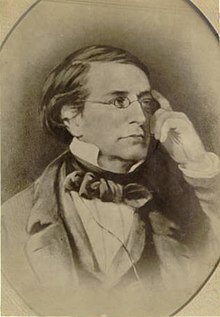| Jacob Whitman Bailey | |
|---|---|
 | |
| Personal details | |
| Born | (1811-04-29)April 29, 1811 Auburn, Massachusetts |
| Died | February 26, 1857(1857-02-26) (aged 45) West Point, New York |
| Spouse |
Maria Slaughter
(m. 1835; died 1852) |
| Children | 3 |
| Education | West Point |
| Occupation | Naturalist |
Jacob Whitman Bailey (1811–1857) was an American naturalist, known as the pioneer in microscopic research in America.
Biography
Jacob Whitman Bailey was born in Auburn, Massachusetts on April 29, 1811, and in 1832 graduated at West Point, where, after 1834, he was successively assistant professor, acting professor, and professor of chemistry, mineralogy, and geology. At West Point he studied with John Torrey. He devised various improvements in the construction of the microscope and made an extensive collection of microscopic objects and of algae, which he left to the Boston Society of Natural History. In 1857 he was president of the American Association for the Advancement of Science, as well as a member of the National Institute for the Promotion of Science, a precursor to the Smithsonian Institution. He was elected an Associate Fellow of the American Academy of Arts and Sciences (AAAS) in 1845. He was elected to the American Philosophical Society in 1852.
Bailey and his son William were survivors of the steamboat Henry Clay disaster on July 28, 1852, though his wife and daughter, both named Maria, were among the casualties.
He wrote many articles on scientific subjects for the American Journal of Science and for scientific societies, a report on the infusorial fossils of California, and a valuable volume of Microscopical Sketches, containing 3000 original figures.
Bailey died on February 26, 1857, at the beginning of his term of office as President of the AAAS. On August 19, 1857, Augustus Addison Gould delivered a speech to the AAAS in commemoration of Bailey's life. The speech was subsequently published in the American Journal of Science and Arts, volume xxv (second series), (New Haven, May 1858). The standard author abbreviation Bailey is used to indicate this person as the author when citing a botanical name.
The genus Baileya, a North American genus of sun-loving wildflowers native to the deserts of northern Mexico and the Southwestern United States was named by botanists William Henry Harvey and Asa Gray in honor of their colleague Jacob Whitman Bailey.
It was Jacob Whitman Bailey that Lieut. Matthew Fontaine Maury wrote a letter to inquiring as to the material from the sea floor brought up with Lt. John Mercer Brook's deep-sea soundings and core samples. From that it was determined that the sea floor where the trans-Atlantic Cable was laid because the samples showed Lieut. M. F. Maury that his "Telegraphic Plateau" was perfect for the underwater cable. The samples Maury sent proved the "Telegraphic Plateau" samples were non-abrasive for such a cable to be laid.
Bailey was buried at the West Point Cemetery.
Sources
- Several editions from 1855 to 1864 that were improved with time as more information was collected entitled "Physical Geography of the Sea" by Matthew Fontaine Maury. Specifically I cite this one: "The Physical Geography of the Sea, and its Meteorology" Eleventh Edition. By M. F. Maury, LL.D. Illustrated with numerous charts and diagrams. SAMPSON LOW, SON & MARSTON, 14 LUDGATE HILL. 1864. (This source is also a full book transcription on https://en.wikisource.org)
- https://en.wikisource.org/Page:Physical_Geography_of_the_Sea_and_its_Meteorology.djvu/343
- Page 317 section §587. Bailey's letter. [Professor Bailey's reply to Lt. Matthew Fontaine Maury on deep sea core samples using Lt. John Mercer Brook's deep sea sounding device and core sampling device.
Also see pages 345+ ]
References
- Makers of American Botany, Harry Baker Humphrey, Ronald Press Company, Library of Congress Card Number 61-18435
- ^ The National Cyclopaedia of American Biography. Vol. X. J. T. White Company. 1900. p. 157. Retrieved July 23, 2020 – via Newspapers.com.
- "Book of Members, 1780-2010: Chapter B" (PDF). American Academy of Arts and Sciences. Retrieved May 5, 2011.
- "APS Member History". search.amphilsoc.org. Retrieved April 16, 2021.
- "The American journal of science and arts. Ser.2,v.25 (I.e.,v.75) 1858". Journal of Science and Arts: 116 v.
- International Plant Names Index. Bailey.
- "Bailey, Jacob W". Army Cemeteries Explorer. U.S. Army. Retrieved August 16, 2022.
External links
 "Bailey, Jacob Whitman". The Biographical Dictionary of America. Vol. 1. 1906. pp. 182–183.
"Bailey, Jacob Whitman". The Biographical Dictionary of America. Vol. 1. 1906. pp. 182–183.- JACOB W. BAILEY AND THE DIATOMS OF THE WILKES EXPLORING EXPEDITION (1838-1842). Robert K. Edgar, Occasional Papers of the Farlow Herbarium of Cryptogamic Botany, No. 14 (July, 1979), pages 9–33 (Jstor stable URL)
- JACOB WHITMAN BAILEY (1811–1857): EHRENBERG'S AMBASSADOR TO AMERICA. John R. Dolan, European Journal of Protistology, 2022, vol. 85, pp.125907. 10.1016/j.ejop.2022.125907
- 1811 births
- 1857 deaths
- People from Auburn, Massachusetts
- United States Military Academy alumni
- Military personnel from Massachusetts
- United States Military Academy faculty
- People of the United States Exploring Expedition
- American science writers
- Shipwreck survivors
- Fellows of the American Academy of Arts and Sciences
- Burials at West Point Cemetery